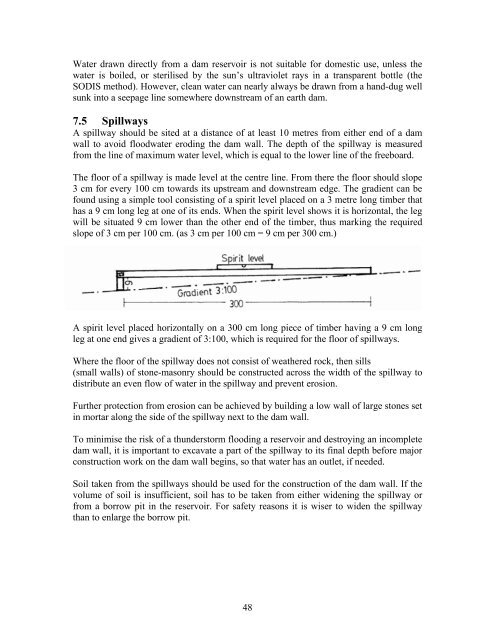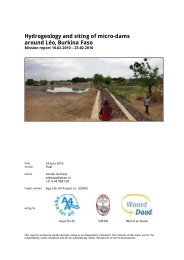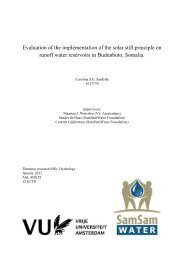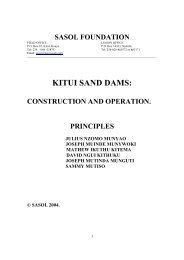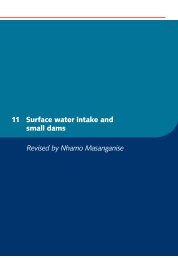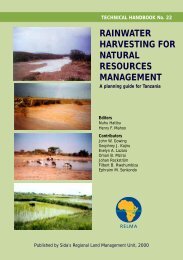Water from Small Dams
Water from Small Dams - SamSamWater
Water from Small Dams - SamSamWater
You also want an ePaper? Increase the reach of your titles
YUMPU automatically turns print PDFs into web optimized ePapers that Google loves.
<strong>Water</strong> drawn directly <strong>from</strong> a dam reservoir is not suitable for domestic use, unless thewater is boiled, or sterilised by the sun’s ultraviolet rays in a transparent bottle (theSODIS method). However, clean water can nearly always be drawn <strong>from</strong> a hand-dug wellsunk into a seepage line somewhere downstream of an earth dam.7.5 SpillwaysA spillway should be sited at a distance of at least 10 metres <strong>from</strong> either end of a damwall to avoid floodwater eroding the dam wall. The depth of the spillway is measured<strong>from</strong> the line of maximum water level, which is equal to the lower line of the freeboard.The floor of a spillway is made level at the centre line. From there the floor should slope3 cm for every 100 cm towards its upstream and downstream edge. The gradient can befound using a simple tool consisting of a spirit level placed on a 3 metre long timber thathas a 9 cm long leg at one of its ends. When the spirit level shows it is horizontal, the legwill be situated 9 cm lower than the other end of the timber, thus marking the requiredslope of 3 cm per 100 cm. (as 3 cm per 100 cm = 9 cm per 300 cm.)A spirit level placed horizontally on a 300 cm long piece of timber having a 9 cm longleg at one end gives a gradient of 3:100, which is required for the floor of spillways.Where the floor of the spillway does not consist of weathered rock, then sills(small walls) of stone-masonry should be constructed across the width of the spillway todistribute an even flow of water in the spillway and prevent erosion.Further protection <strong>from</strong> erosion can be achieved by building a low wall of large stones setin mortar along the side of the spillway next to the dam wall.To minimise the risk of a thunderstorm flooding a reservoir and destroying an incompletedam wall, it is important to excavate a part of the spillway to its final depth before majorconstruction work on the dam wall begins, so that water has an outlet, if needed.Soil taken <strong>from</strong> the spillways should be used for the construction of the dam wall. If thevolume of soil is insufficient, soil has to be taken <strong>from</strong> either widening the spillway or<strong>from</strong> a borrow pit in the reservoir. For safety reasons it is wiser to widen the spillwaythan to enlarge the borrow pit.48


